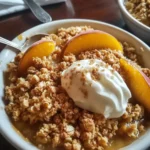The combination of nutty pistachios, delicate rosewater, and creamy milk pudding creates a dessert that is both elegant and comforting. Mouhalabieh is the perfect treat to serve at the end of a meal, with its rich yet light texture and fragrant flavors. It’s a Middle Eastern classic that adds a touch of sophistication to any occasion. The balance between the silky smooth pudding and the crunch of pistachios makes each bite a delightful experience. Whether you are enjoying it after a family dinner or serving it to guests, Mouhalabieh never fails to impress.
Full Recipe:
-
2 1/2 cups whole milk
-
1/2 cup heavy cream
-
1/4 cup sugar
-
2 tablespoons cornstarch
-
1 tablespoon rosewater
-
1/4 cup unsalted pistachios, chopped
-
Ground cinnamon, for garnish
Directions:
-
In a saucepan, whisk together the milk, cream, sugar, and cornstarch over medium heat until the mixture begins to thicken.
-
Stir constantly to avoid lumps and cook until the mixture becomes smooth and creamy, around 10 minutes.
-
Remove from heat and stir in the rosewater.
-
Pour the mixture into serving dishes and allow it to cool to room temperature, then refrigerate for at least 3 hours or until set.
-
Before serving, sprinkle the pistachios on top and garnish with a dash of ground cinnamon.
Prep Time: 10 minutes | Cooking Time: 10 minutes | Total Time: 3 hours 20 minutes (includes refrigeration)
Kcal: 190 kcal | Servings: 4
History and Origin
Mouhalabieh has deep roots in the culinary history of the Levantine region, particularly in countries like Lebanon, Syria, Jordan, and Palestine. It is a classic dessert that reflects the rich culinary traditions of these regions, where dairy-based sweets have always been a staple. While the dessert’s exact origins are difficult to trace, it is believed to date back to ancient times when milk and honey were commonly used in cooking.
The name “Mouhalabieh” is derived from “Muhallab,” a famous 10th-century Arab ruler and food connoisseur known for his love of fine cuisine. It’s said that the dessert was named in his honor, and over time, it evolved into the version we recognize today. In its early forms, it was often flavored with ingredients like rosewater, orange blossom water, and various nuts, with pistachios becoming a popular topping. The use of these ingredients in Mouhalabieh reflects the Middle Eastern appreciation for combining sweet and floral elements with crunchy textures.
Traditionally, Mouhalabieh was reserved for special occasions like weddings and celebrations, but its simple preparation and accessibility have made it a common dessert enjoyed by many in the region. Its popularity has spread far beyond the Middle East, and today, it’s enjoyed by food enthusiasts worldwide, offering a glimpse into the region’s rich dessert heritage.
Variations and Adaptations
While the basic concept of Mouhalabieh remains consistent, there are several regional variations and adaptations that reflect local tastes and available ingredients. The most notable variations typically involve flavorings and toppings.
In Lebanon, for instance, the pudding is often flavored with a subtle hint of rosewater, while in Syria, it may be infused with orange blossom water for a slightly different aromatic profile. The inclusion of rosewater and orange blossom water gives the dessert a unique floral note that adds complexity and elegance to the otherwise creamy base.
Toppings can vary as well. The classic pistachios are a popular choice, but almonds, pine nuts, or hazelnuts are often used in other versions of the pudding. In some regions, a drizzle of syrup or honey might be added for extra sweetness, though it’s not a requirement. Additionally, some variations feature a sprinkle of cinnamon or nutmeg to enhance the flavor profile and add a bit of warmth.
While the traditional recipe calls for heavy cream and whole milk, lighter versions can be made by substituting the cream with coconut milk or almond milk for those seeking a dairy-free alternative. For a more decadent version, some recipes might even incorporate a touch of chocolate or caramel for a fusion twist.
The beauty of Mouhalabieh lies in its versatility. You can adjust the sweetness, flavorings, and toppings to match your personal preferences, making it a dessert that can be tailored to suit a variety of tastes and dietary requirements.
Nutritional Information
Mouhalabieh is generally a high-calorie dessert due to its creamy base, but it offers some nutritional benefits as well. Here’s a breakdown of the essential nutritional components:
-
Calories: Approximately 190 kcal per serving (depending on specific portion size and variations made).
-
Fat: The dessert contains around 12 grams of fat per serving, with much of this coming from the heavy cream and whole milk. These fats are primarily saturated, but they also provide a satisfying richness to the pudding.
-
Protein: Each serving contains about 5 grams of protein, most of which comes from the milk and cream.
-
Carbohydrates: A typical serving provides around 17 grams of carbohydrates, mainly from sugar. This includes the natural sugars from the milk and any added sweeteners like sugar or honey.
-
Fiber: There is minimal fiber in this dessert, although adding nuts like pistachios can increase fiber content slightly.
-
Micronutrients: Mouhalabieh offers several important vitamins and minerals, including calcium and vitamin D from the milk and cream. The pistachios add extra vitamin E, magnesium, and healthy fats to the dessert.
While Mouhalabieh is a rich and indulgent treat, it also offers some nutritional value, particularly if you enjoy it with the pistachio topping, which boosts its protein, healthy fats, and mineral content. However, because of its calorie content, it is best enjoyed in moderation, especially for those watching their calorie intake.
Serving Suggestions and Pairings
Mouhalabieh is a versatile dessert that can be served in many ways. Traditionally, it is presented in small bowls or ramekins, allowing guests to enjoy their own individual portions. You can garnish each serving with a sprinkle of chopped pistachios, a dash of ground cinnamon, or even a few rose petals for an extra touch of elegance. If you’re serving the pudding for a special occasion, consider adding a drizzle of honey or pomegranate molasses to give it an additional layer of sweetness and complexity.
Pairing Mouhalabieh with a hot cup of Arabic coffee or a refreshing mint tea creates a delightful balance between the dessert’s creamy texture and the herbal or bold flavors of the beverage. For a more indulgent pairing, you could serve it with a glass of dessert wine, such as a sweet Moscato or a late-harvest Riesling. The pudding’s light and fragrant flavor complements these drinks beautifully.
For a more modern twist, try serving it alongside a fresh fruit salad, particularly one with citrus or berries, to introduce a burst of freshness that contrasts the pudding’s richness. You can also pair it with a light, flaky pastry like baklava or knafeh for a truly decadent dessert platter.
Tips and Tricks for Success
To ensure your Mouhalabieh turns out perfectly, here are some helpful tips:
Advertisement
-
Constant Stirring: When cooking the milk mixture, be sure to stir constantly to prevent lumps from forming. The cornstarch can thicken quickly, so it’s essential to keep the mixture moving.
-
Don’t Rush the Cooling Process: Allow the pudding to cool to room temperature before refrigerating. This will help it set evenly. Make sure to refrigerate it for at least 3 hours to achieve the right consistency.
-
Adjust the Sweetness: Taste the pudding before chilling it and adjust the sweetness according to your preference. If you prefer a sweeter dessert, add a little more sugar.
-
Flavored Water: If you’re using rosewater or orange blossom water, be mindful of the amount you use. A little goes a long way, and too much can overpower the delicate flavor of the milk pudding.
Potential Health Benefits
Despite being a dessert, Mouhalabieh offers some potential health benefits due to its key ingredients. Here’s a closer look:
-
Calcium and Bone Health: The primary ingredient, milk, is rich in calcium, which is essential for maintaining strong bones and teeth. This makes Mouhalabieh a good option for those looking to boost their calcium intake.
-
Healthy Fats from Pistachios: The pistachios used as a topping provide a good source of healthy fats, which are essential for heart health. They are also rich in antioxidants, which help combat oxidative stress in the body.
-
Rosewater’s Relaxing Properties: Rosewater, often used to flavor the dessert, has been used in traditional medicine for its calming and soothing properties. It is believed to help reduce stress and anxiety.
While Mouhalabieh is not a low-calorie dessert, its ingredients offer some nutritional benefits, particularly when enjoyed in moderation.
Conclusion
Mouhalabieh is more than just a dessert; it’s a piece of Middle Eastern culinary history, offering a rich, indulgent, and aromatic treat that is perfect for any occasion. With its creamy texture, floral undertones, and nutty pistachio topping, it’s a dessert that delights the senses and satisfies any sweet tooth. Whether you’re looking to explore new flavors, add a special touch to a dinner party, or simply enjoy a comforting treat, Mouhalabieh is sure to make a lasting impression. Try it today and experience the elegance of this timeless Middle Eastern dessert!






